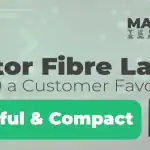A Comprehensive Guide to Making Money with a CO2 Laser

Laser Focus: A Comprehensive Guide to Making Money with a CO2 Laser

Chapters
Introduction to CO2 Lasers:
The photons are then focused by a series of mirrors and directed onto the cut or engraved material. The high-energy photons heat up the material and vaporise it, leaving a clean and precise cut or engraving.
CO2 lasers are widely used in a variety of industries, including manufacturing, aerospace, automotive, and electronics. They are particularly popular for their ability to cut and engrave a wide range of materials, including wood, acrylic, leather, fabric, and even metal.
One of the key advantages of CO2 lasers is their speed and precision. They can cut and engrave at high speeds while maintaining accuracy down to the micron level. This makes them ideal for mass production, as well as for custom and personalised products.
Another advantage of CO2 lasers is their low cost of operation. Compared to other types of lasers, such as fibre lasers and Nd:YAG lasers, CO2 lasers are more affordable and easier to maintain. They also have a longer lifespan, with some models lasting up to 10,000 hours of use.
However, CO2 lasers also have some limitations and challenges. For example, they require proper ventilation to remove smoke and fumes generated during the cutting and engraving process. They also have a limited depth of focus, which can make it difficult to engrave uneven surfaces.
Despite these challenges, CO2 lasers remain a popular and versatile tool for businesses of all sizes. In the following chapters, we’ll explore the various aspects of starting and running a successful laser cutting and engraving business using a CO2 laser.
From choosing the right laser machine and setting up your workshop to designing and preparing files for cutting and engraving, pricing your services, and marketing your business, this article covers it all.
Understanding the Market for Laser Cutting and Engraving Services
One of the primary drivers of demand for laser cutting and engraving services is customisation. Customers today want products that are unique and personalised, and laser technology makes it easy to create one-of-a-kind designs on a wide range of materials.
The signage and promotional products industry is one of the largest markets for laser cutting and engraving services. Companies in this industry use lasers to create custom signs, displays, and promotional items for a wide range of businesses and organisations.
Another growing market for laser cutting and engraving services is the fashion and accessories industry. Laser technology can be used to create intricate designs on leather, fabric, and other materials, allowing designers to create unique and personalized products for their customers.
The jewellery industry is also a significant market for laser cutting and engraving services. CO2 lasers can be used to create custom jewellery designs, including cutting and engraving intricate patterns and designs on metal and other materials.
In addition to these industries, there are also numerous niche markets within the laser cutting and engraving industry. For example, some businesses specialize in creating custom wedding favours, while others focus on industrial prototyping or architectural models.
By understanding the various markets and niches within the laser cutting and engraving industry, you can identify opportunities for growth and expansion, and tailor your services to meet the needs of your target audience. In the following chapters, we’ll discuss how to find your own niche and build a successful laser cutting and engraving business.
Finding Your Niche in the Laser Industry
When choosing your niche, there are several factors to consider. One of the most important factors is your skills and expertise. If you have a background in a particular industry or skillset, such as graphic design or woodworking, you may want to focus on that niche.
Another factor to consider is the materials and applications you’re most interested in. If you enjoy working with a particular material, such as leather or acrylic, you may want to focus on that niche. Similarly, if you have a particular interest in creating custom signs or wedding favours, you may want to focus on those applications.
It’s also important to consider the competition in your local market. If there are already several businesses offering laser cutting and engraving services in your area, you may want to consider a more specialized niche to differentiate yourself.
Some examples of niche markets within the laser cutting and engraving industry include:
- Custom signage and displays
- Wedding favours and decor
- Industrial prototyping and modelling
- Custom jewellery design and engraving
- Personalized gifts and keepsakes
- Architectural models and mock-ups
Choosing the Right CO2 Laser for Your Business
One of the first factors to consider is your budget. CO2 lasers come in a wide range of prices, from a few thousand dollars for a basic desktop model to tens of thousands of dollars for a high-end industrial model. It’s important to choose a laser that fits within your budget, while still meeting your needs for power, speed, and precision.
Another factor to consider is the size and type of materials you’ll be working with. If you’ll be primarily cutting or engraving small items, such as jewellery or promotional products, you may be able to get by with a desktop model. However, if you’ll be working with larger items, such as signs or furniture, you’ll need a larger laser with a bigger bed size.
It’s also important to consider the level of automation and customization you require. Some lasers come with more advanced features, such as autofocus and rotary attachments, that can save you time and improve your precision. However, these features may also come with a higher price tag.
When evaluating different CO2 lasers, it’s important to consider the reputation and support of the manufacturer. Look for a manufacturer with a proven track record of quality and reliability, and make sure they offer comprehensive technical support and training.
By choosing the right CO2 laser for your business, you can ensure that you have the power, speed, and precision you need to meet the needs of your customers. In the following chapters, we’ll discuss how to set up your workshop and design and prepare files for cutting and engraving.
Setting Up Your Laser Workshop for Maximum Efficiency and Productivity
One of the first steps in setting up your workshop is to choose a suitable location. Your workshop should be in a well-ventilated area with good lighting and temperature control. It should also be equipped with a proper electrical supply to support your laser and other equipment.
Once you’ve chosen a location, it’s important to design your workspace with the right layout and equipment. Some tips for optimising your workspace include:
- Creating a separate area for material storage and handling
- Designing a dedicated work area for your laser
- Investing in quality workbenches and storage cabinets
- Installing proper ventilation and air filtration systems
- Installing a dust collection system to reduce debris and contaminants.
- Using ergonomic tools and equipment to reduce fatigue and injury
In the following chapters, we’ll discuss how to design and prepare files for cutting and engraving, as well as some best practices for maintaining and calibrating your laser
Designing and Preparing Files for Cutting and Engraving
One of the most popular software options for designing and preparing files for laser cutting and engraving is Adobe Illustrator. This software allows you to create vector graphics that can be easily imported into your laser software for cutting or engraving.
There are a number of excellent alternatives such as the CAD/CAM that we supply with all of our machines called Lightburn, Affinity Designer (a fantastic, affordable vector package) or something like Inkscape (FREE).
When preparing your files for laser cutting and engraving, there are several important considerations to keep in mind:
- Choose the right materials: Different materials require different settings and techniques for cutting and engraving. Make sure you understand the properties of the materials you’re working with and adjust your settings accordingly.
- Optimise your designs for laser cutting: Laser cutting involves a small kerf or width of the cut, which can cause distortion or inaccuracies in your design. To avoid this, it’s important to create designs that consider the kerf width and any other factors that may affect the accuracy of your cuts.
- Optimise your designs for laser engraving: Laser engraving requires different settings and techniques than laser cutting. To create high-quality engravings, it’s important to choose the right settings for your laser, such as speed, power, and frequency.
- Test your designs before production: Before you start cutting or engraving a large batch of products, it’s important to test your designs and settings to ensure that they’re producing the desired results. This can help you avoid costly mistakes and reduce waste.
Maintaining and Calibrating Your CO2 Laser
One of the most important maintenance tasks for your laser is cleaning. Over time, dust and debris can accumulate on the mirrors and lenses inside your laser, reducing its power and accuracy. It’s important to clean your laser regularly using a lint-free cloth and a specialised cleaning solution.
Another important maintenance task is checking and replacing the laser tube. The laser tube is a critical component of your laser, and over time it can become less effective. It’s important to check your laser tube regularly and replace it if necessary.
Calibration is also an important part of maintaining your laser. By calibrating your laser regularly, you can ensure that it’s producing accurate cuts and engravings. Calibration involves adjusting the mirrors and lenses inside your laser to ensure that the laser beam is focused and directed correctly.
In addition to maintenance and calibration, it’s important to keep up with software updates and upgrades for your laser. This can help you take advantage of new features and improvements and ensure that your laser is compatible with the latest design software.
By maintaining and calibrating your CO2 laser regularly, you can ensure that it’s producing high-quality cuts and engravings while avoiding costly repairs and downtime. In the following chapters, we’ll discuss how to maximise your efficiency and productivity in your laser workshop, including tips for workflow optimisation and automation.
Maximising Efficiency and Productivity in Your Laser Workshop
One of the first steps in optimising your workflow is to streamline your file preparation and cutting processes. This can involve using software tools to automate certain tasks, such as file preparation and nesting, or using pre-made templates and designs to speed up your production.
Another important factor in maximising your efficiency and productivity is investing in the right equipment and tools. This may include additional lasers, or tools and equipment to help you handle and process materials more efficiently.
It’s also important to optimise your workspace to reduce wasted time and effort. This can involve organizing your materials and tools in a way that makes them easily accessible or using ergonomic tools and equipment to reduce fatigue and injury.
Another key factor in maximising your efficiency and productivity is to use automation and other tools to reduce errors and increase accuracy. This can involve using sensors and other monitoring tools to ensure that your laser is producing accurate cuts and engravings or using software tools to optimise your cutting and engraving settings.
By maximising your efficiency and productivity in your laser workshop, you can increase your output, reduce your costs, and improve your bottom line. In the following chapters, we’ll discuss how to price your services and market your laser cutting and engraving business to reach new customers and grow your business.
Pricing Your Laser Cutting and Engraving Services
When pricing your services, there are several factors to consider:
- Your costs: This includes the cost of your materials, equipment, and overhead expenses, such as rent and utilities.
- Your competition: Research the prices of other laser cutting and engraving businesses in your area to ensure that your prices are competitive.
- Your target audience: Consider the demographics of your target audience and their willingness to pay for custom laser cutting and engraving services.
- Your level of expertise and experience: If you have a high level of skill and expertise, you may be able to charge a premium for your services.
- Your value proposition: Consider the unique value that you offer to your customers, such as customization or a specific niche, and adjust your prices accordingly.
It’s also important to consider the different pricing models that are common in the laser cutting and engraving industry.
Some businesses charge by the hour, while others charge by the project or by the piece. Consider which model works best for your business and adjust your pricing accordingly.
By pricing your laser cutting and engraving services properly, you can ensure that you’re making a profit while still offering competitive prices to your customers. In the following chapters, we’ll discuss how to market your business to reach new customers and grow your business.
Marketing Your Laser Cutting and Engraving Business
One of the first steps in marketing your business is to develop a strong brand identity. This includes creating a logo, establishing a consistent visual style, and developing a unique value proposition that sets you apart from your competition.
Once you have a strong brand identity, you can start promoting your business through a variety of marketing channels, such as:
- Social media: Use social media platforms like Facebook, Instagram, and Twitter to showcase your work, interact with customers, and promote your services.
- Website: Create a professional website that showcases your work, provides information about your services, and makes it easy for potential customers to get in touch with you.
- Email marketing: Build an email list of customers and potential customers and use email marketing to promote your services and share news and updates about your business.
- Print materials: Design and print flyers, brochures, and business cards to distribute to potential customers and at local events and trade shows.
- Networking: Attend local networking events and trade shows to meet potential customers and establish relationships with other businesses in your industry.
By developing a strong marketing strategy and using the right channels to reach your target audience, you can increase your visibility, attract new customers, and grow your laser cutting and engraving business.
Building Customer Relationships for Long-Term Success
One of the first steps in building strong customer relationships is to establish clear lines of communication. This involves being responsive to customer inquiries and feedback and providing regular updates on the status of their projects.
It’s also important to provide customized solutions that meet the unique needs of each customer. This may involve offering custom design services or tailoring your production process to their specific requirements.
Another important factor in building strong customer relationships is to provide excellent customer service. This includes being friendly and professional in all interactions and being willing to go above and beyond to ensure customer satisfaction.
In addition to providing excellent customer service, it’s important to build a strong online presence that showcases your work and provides information about your services. This can include creating a portfolio of your work, showcasing customer testimonials, and providing information about your production process and capabilities.
By building strong customer relationships, you can increase customer loyalty and generate repeat business, which is critical to the long-term success of your laser cutting and engraving business. In the following chapters, we’ll discuss how to expand your business and take your laser cutting and engraving services to the next level.
Expanding Your Laser Cutting and Engraving Business
- Offer new services: Consider expanding your services to include new types of cutting or engraving, such as 3D printing, UV printing, or laser etching. This can help you reach new customers and increase your revenue.
- Diversify your product offerings: Branch out into new markets by offering various products, such as custom signage, promotional products, or personalised gifts.
- Partner with other businesses: Partnering with other businesses in your industry or related fields can help you expand your reach and offer more comprehensive services to your customers.
- Invest in new equipment: Investing in new equipment, such as a larger laser or a CNC router, can help you take on larger projects and increase your production capabilities.
- Open a physical storefront: If you’re currently operating out of a home workshop, consider opening a physical storefront to increase your visibility and attract more customers.
Careful planning and research can help you make informed decisions and ensure the long-term success of your business.
In the following chapters, we’ll discuss how to manage your finances and resources effectively to support your business growth and success.
Managing Your Finances and Resources for Business Success
One of the first steps in managing your finances is to develop a realistic budget that considers all of your expenses and revenue streams. This may include expenses such as equipment purchases, rent, utilities, and marketing, as well as revenue streams such as sales and services.
Another important aspect of financial management is tracking your expenses and revenue on a regular basis. This can help you identify areas where you can reduce costs or increase revenue and make informed decisions about investments and expansion.
It’s also important to manage your resources effectively, including your time, materials, and personnel. This may involve optimising your production process to reduce waste and increase efficiency, as well as developing a schedule and workflow that maximises productivity and minimizes downtime.
In addition to financial and resource management, it’s important to develop a strong team of employees and contractors who can support your business’s growth and success. This may involve hiring additional employees, outsourcing certain tasks, or partnering with other businesses to expand your capabilities.
By managing your finances and resources effectively, you can ensure that you have the resources you need to grow and expand your laser cutting and engraving business while minimising risk and maximising profitability. In the following chapters, we’ll discuss how to stay up to date with the latest trends and technologies in the laser cutting and engraving industry.
Staying Up to Date with Laser Cutting and Engraving Trends and Technologies
One of the best ways to stay up to date with the latest trends and technologies is to attend trade shows and conferences in your industry.
These events offer opportunities to learn from experts, see the latest products and technologies, and network with other professionals in your field.
Another important way to stay informed is to subscribe to industry publications and newsletters, such as laser cutting and engraving magazines and blogs. These resources can provide valuable insights into new technologies, emerging trends, and best practices for your business.
It’s also important to stay informed about software updates and upgrades for your laser cutting and engraving equipment. By staying up to date with the latest software, you can take advantage of new features and improvements that can help you increase your efficiency and productivity.
In addition to staying informed about trends and technologies, it’s important to continue learning and improving your skills as a laser cutting and engraving professional. This may involve attending workshops or training programs or investing in new equipment or software that can help you expand your capabilities.
By staying up to date with the latest trends and technologies in the laser cutting and engraving industry, you can ensure that your business stays competitive and successful for years to come. In the following chapter, we’ll discuss how to develop a strategic plan for your business’s growth and success.
Developing a Strategic Plan for Business Growth and Success
Here are some steps to developing a strategic plan for your laser cutting and engraving business:
- Define your goals: Identify your long-term goals for your business, such as increasing revenue, expanding your customer base, or offering new services.
- Conduct a SWOT analysis: Identify your strengths, weaknesses, opportunities, and threats as a business. This can help you identify areas where you can improve and areas where you can capitalize on opportunities for growth.
- Develop a mission statement: Create a clear and concise mission statement that defines your business’s purpose and values.
- Identify your target audience: Define your ideal customer and identify the demographics, needs, and preferences of your target audience.
- Develop a marketing and sales strategy: Develop a plan for reaching your target audience and promoting your services, including marketing channels, messaging, and pricing.
- Create an action plan: Define specific actions and timelines for achieving your goals, such as investing in new equipment, expanding your services, or launching a new marketing campaign.
- Monitor and evaluate progress: Regularly evaluate your progress and adjust your strategy as needed to ensure that you’re on track to achieving your goals.
Conclusion
From selecting the right equipment and materials to developing a strong brand identity and marketing strategy to managing your finances and resources effectively, there are many factors to consider when starting and growing your laser cutting and engraving business.
By staying up to date with the latest trends and technologies, building strong customer relationships, and developing a strategic plan for growth and success, you can position your business for long-term success and achieve your goals as a laser cutting and engraving professional.
Remember to stay focused, be persistent, and continue learning and improving your skills as a laser cutting and engraving professional. With hard work and dedication, you can build a successful business that provides high-quality, customized services to a wide range of customers.
Thank you for taking the time to read this guide on starting and growing a laser cutting and engraving business. We hope that you have found the information and strategies outlined in this guide to be helpful in your own journey as a laser cutting and engraving professional.
Starting a new business can be challenging, but with the right tools, resources, and strategies, you can build a successful business that provides high-quality, customised services to a wide range of customers.
Remember to stay focused on your goals, stay up to date with the latest trends and technologies, and continue learning and improving your skills as a laser cutting and engraving professional.
We wish you the best of luck in your endeavours and hope that your laser cutting and engraving business is a great success.
Disclaimer
The use of any information provided in this guide is solely at your own risk. Manteche shall not be liable for any damages or injury arising from the use or reliance on any information provided in this guide.
It is important to consult with qualified professionals, such as lawyers and accountants when starting or operating a business. Additionally, regulations and laws regarding business ownership and operation may vary by location and industry. Always research and comply with all applicable laws and regulations in your area.




